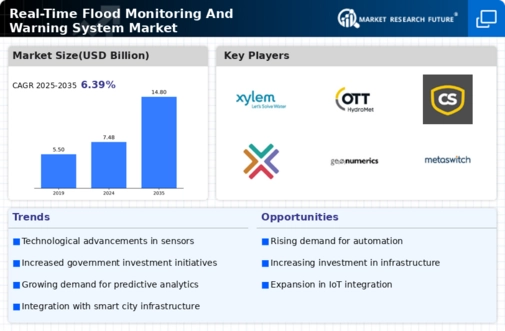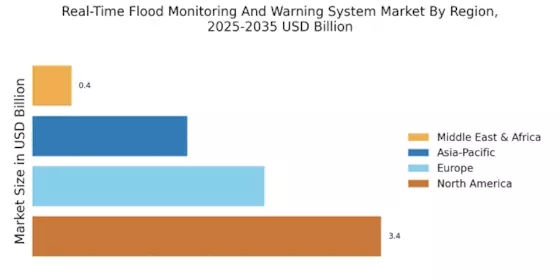Urbanization and Population Growth
Urbanization and population growth are significant factors influencing the Real-Time Flood Monitoring And Warning System Market. As urban areas expand, the risk of flooding increases due to higher impervious surfaces and inadequate drainage systems. This trend necessitates the implementation of effective flood monitoring systems to protect densely populated regions. Reports indicate that urban areas are particularly vulnerable to flooding, prompting local governments to invest in real-time monitoring technologies. The increasing population density in these areas amplifies the need for timely flood warnings to ensure public safety. Consequently, the market is likely to experience growth as cities prioritize the development of comprehensive flood management strategies to address these challenges.
Government Regulations and Policies
Government regulations and policies are crucial drivers in the Real-Time Flood Monitoring And Warning System Market. Many countries are implementing stricter regulations regarding flood management and disaster preparedness, which necessitates the adoption of advanced monitoring systems. These regulations often mandate the use of real-time data for effective decision-making during flood events. As a result, municipalities and organizations are compelled to invest in sophisticated flood monitoring technologies to comply with these regulations. The increasing focus on disaster risk reduction and climate adaptation policies further emphasizes the need for reliable flood warning systems. This regulatory environment is expected to stimulate market growth as stakeholders align their strategies with governmental requirements.
Increased Investment in Infrastructure
Investment in infrastructure plays a pivotal role in the Real-Time Flood Monitoring And Warning System Market. Governments and private entities are increasingly allocating funds to enhance flood management systems, recognizing the need for robust infrastructure to mitigate flood risks. This investment often includes the installation of advanced monitoring systems, flood barriers, and drainage improvements. According to recent reports, infrastructure spending related to flood management is expected to reach billions annually, reflecting a growing commitment to disaster preparedness. Such financial backing not only supports the development of innovative technologies but also ensures that communities are better equipped to handle flood events. The emphasis on infrastructure development is likely to drive market growth and improve overall resilience against flooding.
Rising Awareness of Climate Change Impacts
The Real-Time Flood Monitoring And Warning System Market is significantly influenced by the rising awareness of climate change impacts. As extreme weather events become more frequent and severe, communities are increasingly recognizing the importance of effective flood monitoring and warning systems. This heightened awareness drives demand for advanced technologies that can provide timely and accurate flood forecasts. Studies indicate that regions prone to flooding are investing more in real-time monitoring systems to enhance their preparedness and response capabilities. The growing understanding of climate-related risks is likely to propel market growth, as stakeholders seek to implement proactive measures to safeguard lives and property from flooding.
Technological Advancements in Monitoring Systems
The Real-Time Flood Monitoring And Warning System Market is experiencing a surge in technological advancements, particularly in sensor technology and data analytics. Innovations such as IoT-enabled devices and machine learning algorithms enhance the accuracy and speed of flood predictions. For instance, the integration of satellite imagery and real-time data collection allows for more precise monitoring of water levels and rainfall patterns. This technological evolution not only improves the reliability of flood warnings but also facilitates timely responses from emergency services. As a result, the market is projected to grow significantly, with estimates suggesting a compound annual growth rate of over 10% in the coming years. The adoption of these advanced technologies is crucial for developing effective flood management strategies.


















Leave a Comment